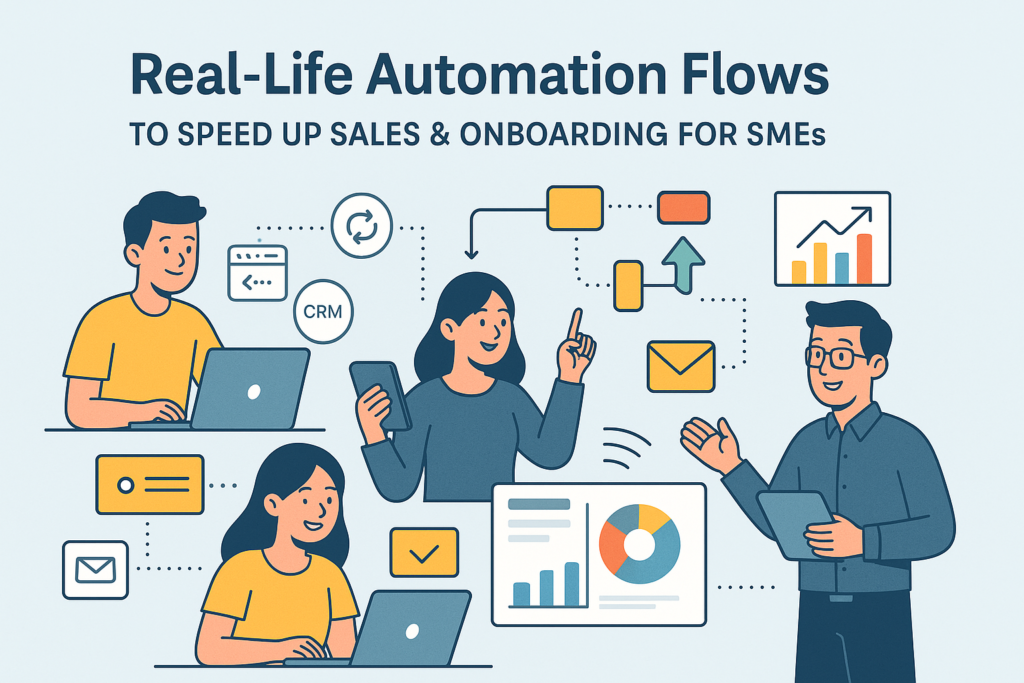For growing businesses, speed matters—especially when it comes to turning leads into customers. However, most SMEs still rely on manual processes for capturing leads, following up, and onboarding. That’s where business automation flows for SMEs become essential.
Automation tools like Zapier, Make (Integromat), and CRMs such as Zoho, HubSpot, Keap, Vtiger and GoHighlevel can automate repetitive tasks and make your sales and onboarding faster, smoother, and more reliable.
Let’s walk through some real-world automation flows that small businesses are using to save time and grow faster. These examples will also give you a sneak peek at what we’ll explore in more detail in the coming weeks.

1. Lead Capture → CRM with Zero Delay
Instead of manually entering every lead, you can set up automations that:
- Pull form submissions directly from your website
- Instantly create contacts in Zoho or HubSpot
- Automatically assign lead sources and tags
- Trigger emails or tasks for your team to take action
As a result, your lead handling process becomes both faster and more reliable.
➡️ Coming soon: A full guide to automating lead capture, including UTM tracking for attribution.
2. Automated Follow-Up Sequences
Following up quickly is crucial. Fortunately, automation tools allow you to:
- Send welcome emails as soon as a lead enters your CRM
- Schedule follow-ups via email or SMS
- Notify your sales team with reminders
- Personalize messages based on lead behavior
This not only saves time but also helps you build trust faster.
➡️ Stay tuned for our blog on setting up end-to-end follow-up flows using Make and Keap.
3. Smart Onboarding for New Customers
Onboarding sets the stage for long-term loyalty. Here’s what automation can do:
- Deliver welcome messages or access instructions immediately
- Update project or tracking sheets in Google Sheets
- Alert internal teams to begin the next steps
- Schedule follow-up surveys automatically
Ultimately, this ensures your customers feel guided from day one.
➡️ Our upcoming post will explain how to automate onboarding using CRMs and email tools.
4. Internal Team Alerts & Task Assignments
A seamless experience requires coordinated teamwork. To that end, automation can:
- Notify specific people via Slack or email
- Create tasks in Trello, Asana, or your CRM
- Move leads to the right stage in your sales pipeline
Therefore, no one misses a beat—even as your business grows.
➡️ We’ll cover real-time team task automation in a dedicated post soon.
5. Automated Dashboard Reporting
Your team needs data to make decisions. Thankfully, automations can:
- Send weekly reports without fail
- Keep Power BI dashboards current
- Flag performance dips before they cause damage
In short, this eliminates the hassle of manual reporting forever.
➡️ Look out for our no-code guide to automating real-time dashboard reporting.
Conclusion: Automate One Workflow at a Time
Business automation doesn’t require a full overhaul from day one. Instead, start with one time-consuming task—like lead capture or onboarding—and build from there.
Over the coming weeks, we’ll break down each of these flows with detailed, step-by-step blogs.
Not sure where to begin? We can help you automate your business with the right tools and strategy.
